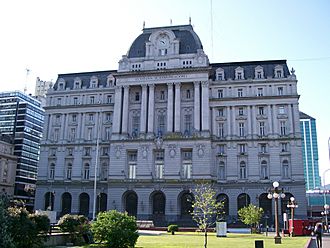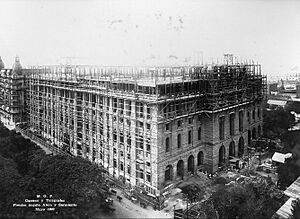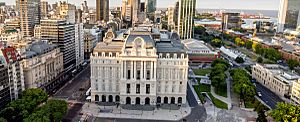Buenos Aires Central Post Office facts for kids
Quick facts for kids Central Post Office |
|
|---|---|
|
Correo Central
|
|

The building in 2007.
|
|
| General information | |
| Town or city | Buenos Aires |
| Country | Argentina |
| Construction started | 1889 |
| Inaugurated | 1928 |
| Renovated | 2015 |
| Owner | Government of Argentina |
| Height | 60 m (200 ft) |
| Technical details | |
| Floor area | 88,050 m2 (947,800 sq ft) |
| Design and construction | |
| Architect | Norbert Maillart |
The Buenos Aires Central Post Office building is a famous landmark in Buenos Aires, Argentina. It was once the main office for the Argentine Post Office. Today, it is known as the Kirchner Cultural Centre. You can find it in the San Nicolás, Buenos Aires neighborhood.
A French architect named Norbert Maillart designed this impressive building. He used styles like Beaux-Arts and Second Empire. Construction began in 1899. After some long breaks and design changes, it finally opened in 1928.
In 1997, the Palacio de Correos was recognized as a National Heritage site. This was because of its amazing architecture, important history, and the artworks inside. It stopped being a post office in 2003. A few years later, the government decided to turn it into a cultural centre. This was part of the celebrations for Argentina's 200th anniversary of the May Revolution. It was first called "Centro Cultural del Bicentenario." In 2012, its name changed to "Néstor Kirchner Cultural Centre."
After a lot of work and restoration, the Central Post Office building reopened in May 2015. It is now the Néstor Kirchner Cultural Centre. It is the largest cultural center in Latin America. It's also the fourth largest cultural center in the entire world!
Contents
History of the Central Post Office
Why a New Post Office?
In the late 1800s, more and more people in Argentina were using postal services. Because of this, the Post Office director, Ramón Cárcano, suggested building a special new home for the Postal Service. The government hired a French architect, Norbert-Auguste Maillart, to design it.
Maillart got his idea from the City Hall Post Office in New York City. President Miguel Juárez Celman approved the plan. Maillart started building in 1889. The land was given by a company called Las Catalinas. It was located near Leandro N. Alem Avenue and Corrientes Avenue. However, work stopped in 1890. This was due to an economic problem that caused President Juárez Celman to leave office.
Changes to the Design
It took until 1905 for the government to provide money to finish the building. Many years had passed, and Maillart's first design was now too small. The postal service had grown even more! So, the new post director, Ernesto Bosch, suggested a bigger design. Maillart was hired again in 1908 to work on the new plan.
The new design included an entrance on Sarmiento street. There were plans for bridges and walkways to help people get to the building easily. These would connect different streets to the building's entrances. Some buildings nearby, like the Stock Exchange, were even built with these plans in mind. But these connecting structures were never actually built.
Finishing the Palace
In 1911, Maillart left the project because he disagreed with the authorities. The National Direction of Architecture then chose Maillart's main helper, Jacques Spolsky, to continue. Spolsky was a Russian architect who had already designed post offices in Tucumán and Rosario.
Spolsky made big changes to the original design. He added a metal structure and used new materials like cement. The land where the building stood was once part of the Río de la Plata river. So, workers had to sink 2,882 concrete piles, each about 10 m (33 ft) deep. This was to make sure the foundations were strong.
In 1916, construction faced more problems. World War I caused economic issues and a lack of materials. Because of this, the plans for bridges and inclined walkways were stopped. This meant some parts of the palace had to be changed. For example, windows on the second floor were originally meant to be entrances. So, new floors were added inside to make them windows instead.
Money ran out again in 1923. A new law was passed to get more funds, and a new company took over the work. The building was finally opened on September 28, 1928. This was just two weeks before President Marcelo T. de Alvear finished his time in office.
Later, during the time of President Juan Perón, he and his wife Eva Perón had offices in the Central Post Office. Eva Perón's foundation also used the building as its main office.
In 1997, the Palacio de Correos was officially declared a National Heritage site. This recognized its beautiful architecture and important history. In 2002, the building stopped being the main office for Correo Argentino. Only a small part of it on Sarmiento Street continued to operate as a post office and sell stamps.
Kirchner Cultural Center
The building became mostly empty in 2005. At that time, President Néstor Kirchner saw a great chance. He wanted to turn the old building into a huge cultural center. After nine years of construction and renovation, it opened in 2015. It is now known as the Néstor Kirchner Cultural Centre.
See also
 In Spanish: Correo Central (Buenos Aires) para niños
In Spanish: Correo Central (Buenos Aires) para niños
- Correo Argentino
- Buildings and structures in Buenos Aires
- National Historic Monuments of Argentina




